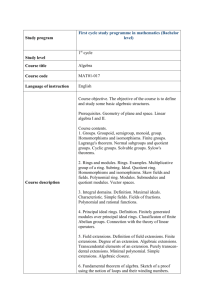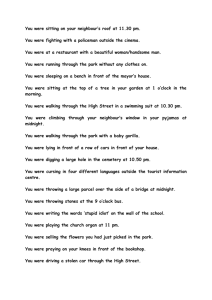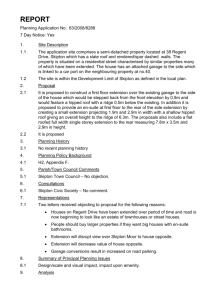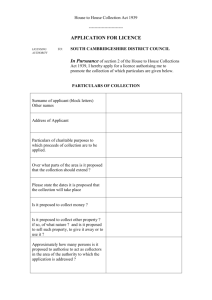Householder Design Guide - South Cambridgeshire District Council
advertisement
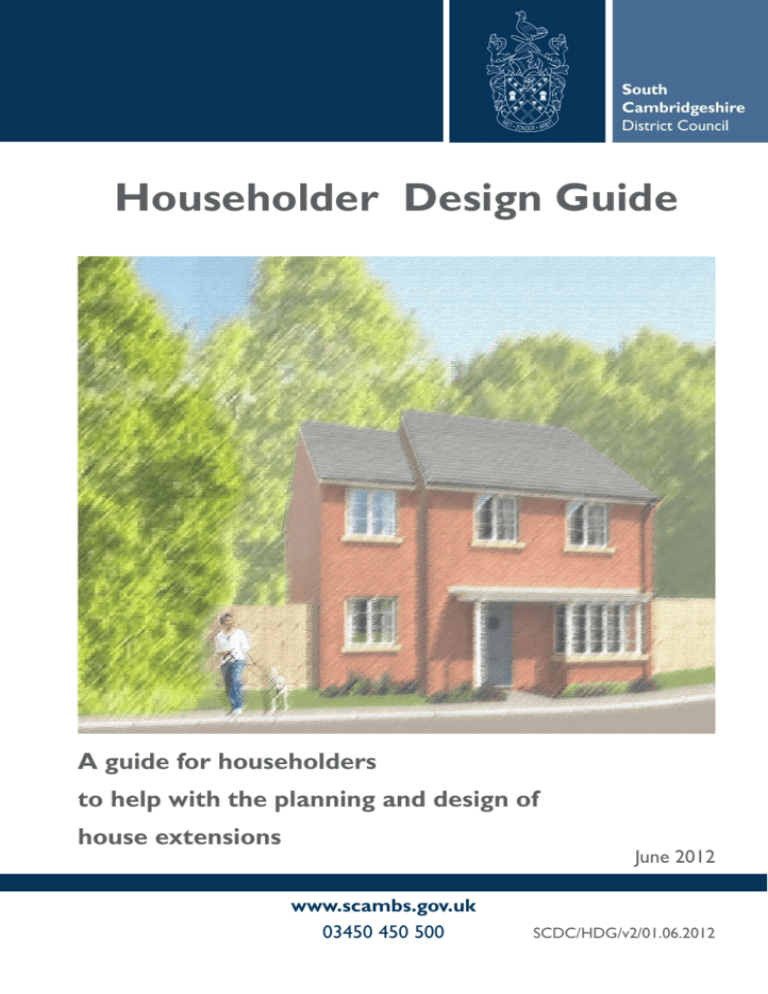
Householder Design Guide A guide for householders to help with the planning and design of house extensions June 2012 www.scambs.gov.uk 03450 450 500 SCDC/HDG/v2/01.06.2012 Content 1.0 1.1 1.2 Introduction Pre-application Planning Advice Service General Permitted Development Order (GPDO) 1 1 2 2.0 2.1 2.2 2.3 2.4 2.5 2.6 2.7 2.8 Before You Start Work Respect for Neighbours Disabled Access Building Regulations Listed Buildings & Conservation Areas Planning Conditions Flood Risk Party Walls Trees 3 3 4 5 6 7 8 9 10 3.0 3.1 3.2 3.3 3.4 Designing the Extension Side Extensions Rear Extensions Dormer Windows Garages and Carports 11 12-14 15-16 17 18 4.0 4.1 4.2 4.3 4.4 Overlooking Overbearing Overshadowing Daylight The 45 degree rule 19 20 20 21 21-25 5.0 How to apply for Planning Permission 26-27 6.0 Glossary 28-29 Words marked with an asterisk (*) are explained in the glossary 1.0 Introduction This guide is intended to help you when considering extending your home. It will help you with the design and give you guidance on how to apply for planning permission*. As every house contributes to the general character of its street and the neighbourhood, it is important that the design of the proposed extensions is in keeping with both the original house and the local area. This Guide should help you achieve a well designed extension, which will positively enhance your existing home. 1.1 Pre-application Planning Advice Service South Cambridgeshire District Council welcomes and encourages discussions before a planning application is submitted. Such discussions can assist in better quality applications, which stand a better chance of a successful outcome. There are considerable benefits in seeking advice before making an application: • It can identify at an early stage where there is a need for specialist input, for example about Listed Buildings* or trees • It may lead to a reduction in time spent by your professional advisors in working up proposals, identifying potential problems and sorting them out before an application is submitted • It may indicate that a proposal is completely unacceptable, saving you the cost of pursuing a formal application • It will help you identify all the necessary information required for a planning application The current charges for householder pre-application advice service are £42 for written advice only, and £60 for a meeting with a planning officer followed by written advice (inclusive of VAT). 1 1.2 General Permitted Development Order (GPDO) Planning permission* is normally required before any development can be carried out, although certain types of extensions can be classified as Permitted Development* and do not require planning permission under the General Permitted Development Order. You are advised to contact our Planning Service Duty Officer, giving details of your proposals, including location of the site and dimensions of the extension, to find out if your proposals need planning permission before you start any building work. This advice is available free of charge and may help avoid extra costs and delays. Our Planning Service Duty Officer Service is available between the hours of 9am to 5pm Monday to Friday and the contact details are as follows: Planning Service Duty Officer Tel: 0345 045 5215 Or visit: South Cambridgeshire District Council South Cambridgeshire Hall Cambourne Business Park Cambourne Cambridgeshire CB23 6EA 2 2.0 Before You Start Work The following questions will help you with the style, form and design of the extension: 1. Analyse your home • What shape and size are the windows and doors? • What shape is the roof? • How much space is there around your home? • What materials is it constructed from? • How much garden area do you have? 2. Analyse your street • How much space is there between properties? • How far back are the properties from the road? • How do people define their boundaries? • What are the houses like next door to yours and across the street? 2.1 Respect for Neighbours Generally we encourage potential applicants to consider discussing their proposals with their neighbours before making a planning application. Not only will your neighbours feel that you have made an effort to keep them informed, it can also avoid your neighbours becoming alarmed when they receive our notification letter. 3 2.2 Disabled Access Whilst there is no requirement under the current planning legislation or Building Regulations* to create disabled access to your proposed extension, we would encourage the provision of a ramped access to any new external doorway to your extension so that visitors with mobility difficulties can gain access more easily. Doors should have a clear width of 800mm to make access easier for the elderly, pushchairs and additionally for furniture removal. Further advice on this issue can be obtained from the our Building Control Team. You can contact the Team in one of the following ways: Tel: 03450 450 500 Fax: 01954 713 152 Email: building.control@scambs.gov.uk Post: Building Control Manager South Cambridgeshire District Council South Cambridgeshire Hall Cambourne Business Park Cambourne Cambridgeshire CB23 6EA DX: 729500 Cambridge 15 4 2.3 Building Regulations The majority of extensions, regardless of whether or not they require planning permission*, will require Building Regulations* consent. Planning permission and Building Regulations consent are two separate requirements: obtaining planning permission does not mean that you have obtained Building Regulations consent, and vice versa. Most construction works will need to comply with Building Regulations. These include the replacement of windows, new electrical installations and renovation of a building. You are advised to contact our Building Control Team as early as possible to discuss your proposals. See page 4 for contact details. 5 2.4 Listed Buildings & Conservation Areas Special care and attention is required when extending a Listed Building* or a property within a Conservation Area*. The design of your extension should be informed by the historical context of the site and this should be explained in the Heritage Statement*. A Heritage Statement and a Design and Access Statement* are required to accompany any application for Listed Building consent or planning application in a Conservation Area. You are advised to contact our Conservation Team to discuss your proposals. Further information on historic buildings can be found on: www.scambs.gov.uk/Environment/Conservation/HistoricBuildings/default.htm Information of Heritage Statement can be found on: www.scambs.gov.uk/documents/retrieve.htm?pk_document=909130 Information of Design and Access Statement can be found on: www.planningportal.gov.uk/planning/applications/howtoapply/whattosubmit/ designaccess Tel: 03450 450 500 Fax: 01954 713 149 Email: conservation@scambs.gov.uk Post: Conservation Team South Cambridgeshire District Council South Cambridgeshire Hall Cambourne Business Park Cambourne Cambridgeshire CB23 6EA 6 5 2.5 Planning Conditions Planning conditions on previous planning permissions* often regulate what can be done to walls, fences, garages, or remove the permitted development right to extend without permission. It is important to be aware of such conditions before submitting an application for householder development. We advise you to contact us to find out if your home is affected by such conditions before contemplating any work to your property. We operate a Duty Planning Officer system between the hours of 9am to 5pm Monday to Friday, enabling us to answer your general planning queries. See page 2 for contact details. 7 2.6 Flood Risk Where the property to be extended is located within a designated flood risk zone, we will expect the issue of flood risk to be adequately addressed through the design of the proposed extension. Further advice and guidance is available from the Environment Agency’s website: www.environment-agency.gov.uk/homeandleisure/floods/default.aspx You can find out if your property lies within a designated flood risk zone by contacting the Planning Service Duty Officer. See page 2 for contact details. 8 2.7 Party Walls Extensions and walls that are built right on the boundary can often cause problems. In many cases the consent of adjoining owners will be necessary. If you intend to carry out work on, or within close proximity to, your neighbour’s boundary or party walls*, you will need to consider the requirements of the Party Wall Act. This is designed to resolve disputes, which may arise between neighbours when building work is carried out. The basic requirement of the Act is that you notify your neighbour of the intended work. The Party Wall Act is not administered by our Building Control Team, but further information can be obtained by contacting the Team. See page 4 for contact details. Further advice and guidance is available from Government’s publication ‘The Party Wall etc. Act 1996: explanatory booklet’ . It is available to download from the following website: www.communities.gov.uk/publications/planningandbuilding/partywall 9 2.8 Trees Where possible, you should site your extension to avoid the removal of significant and healthy trees. You need to ensure that if a young tree is to remain close to the extension, it will have enough room for future growth. This will help ensure that the tree does not have to be removed in the future if it begins to affect the structure of the extension. If the loss of a tree is unavoidable, a replacement tree should be planted in another location within the site. We can serve a Tree Preservation Order (TPO) in order to protect important trees. It is an offence to cut down, lop, uproot, willfully damage and/or destroy a TPO tree without first seeking our permission. A check should therefore be made to identify any TPO trees that stand within the area of the extension or works. Every effort should me made to avoid damage to trees during building works, including damaging roots. If you are planning to undertake tree works or hedge removal and are not sure if your tree is protected, you should contact the Council’s Trees and Landscape Service for advice. Trees and Landscape Officer Tel: 03450 450 500 Fax: 01954 713 152 Email: treesandlandscapes@scambs.gov.uk Post: Trees & Landscape Service Conservation & Design South Cambridgeshire Hall Cambourne Business Park Cambourne Cambridgeshire CB23 6EA 10 3.0 Designing the Extension Your extension must be of a style, form and design that is appropriate and respectful to the character of the locality and the appearance of your existing house. It must not unreasonably impact on your neighbours. Extensions to Mid Terraced properties Extensions to mid terraced properties will only generally be accepted where they are permitted by the General Permitted Development Order* (GPDO). Further details on GPDO can be found on the following website: www.legislation.gov.uk/uksi/1995/418/contents/made Extensions to the Front of a property Extensions to the front of a property towards the highway* will normally need planning permission. Wherever possible, extensions should be positioned to the rear or side of houses. Extensions to the front of properties can disrupt the pattern of the buildings in a street and obscure the original elevation*, therefore they are generally discouraged. However, small and suitably designed porches at the front of a property may be acceptable. Porches: • should respect the character of the house and street • should not conflict or compete with existing architectural features such as bay windows • porch roofs should reflect the design and shape of that of the existing house 11 3.1 Side Extensions Detached, Semi-detached or End-terraced Properties Side extensions should be designed to: • be set back 450mm from the front elevation* • have the ridge level lower than the main ridge • have a hipped or pitched roof match with the original in terms of pitch and shape • leave at least a 750mm distance between the extension and the side boundary for maintenance and access. • have materials that match the original house in type, colour and detail Corner Plots Great care is needed in the design of extensions to corner plots, which often provide an open appearance with greenery. It is important to retain space between any pavement and the side wall of an extension to a corner building with a gable facing the road, in order to protect the open character and visual quality of the area. The following criteria for corner plots should be met in addition to the above requirements: • The width of the extension should not be more than half the width of the original frontage of the property • The depth of the extension should not be more than half the depth of the garden 12 Side Extensions Example A: Original house Proposed side extension Flat roofs will not normally be permitted on two-storey extensions where they are visible from the street. However, they may be acceptable on single-storey or rear extensions. Example B: Original house Proposed side extension Poorly designed side extension without setback are normally considered unacceptable. Side extensions to detached and semi-detached properties should normally be set back from the front of the original property, and set down from the ridge line to ensure that it does not adversely detract from the design of the original property. 13 Side Extensions Example C: Original house Proposed side extension The windows in this extension do not match the windows of the existing property in terms of design and scale. This extension would normally be considered unacceptable. Example D: Original house Proposed side extension In this example, the side extension has been set back with its ridge line set down by a sufficient amount to ensure that it does not overly dominate the original property. This approach would normally be considered acceptable in design terms. 14 3.2 Rear Extensions: Single-storey Rear extensions, including conservatories, should not dominate, nor significantly alter, the existing levels of sunlight, privacy and daylight to adjoining and adjacent properties. Single-storey rear extension The following aspects should be considered when designing a single-storey rear extension: • size, height, orientation and materials • proximity to the boundary and windows of adjacent properties • the size of the remaining garden • the extent to which any adjacent properties have already been extended Consideration will be given to the use of mono-pitched roofs for single-storey extensions thus overcoming the problems of building up to the boundary and overhanging gutters. Semi-detached or End-terraced properties For semi-detached or end-terraced properties, a single-storey extension is generally acceptable if: • It does not cause any significant loss of daylight to the principal habitable rooms* in neighbouring properties (further information on daylight issues can be found on page 21 of this document) • Its length does not exceed 3m measured externally Detached properties For detached properties, a single-storey extension is generally acceptable if: • It does not cause any significant loss of daylight to the principal habitable rooms in neighbouring properties (further information on daylight issues can be found on page 21 of this document) • Its length does not exceed 4m measured externally 15 3.2 Rear Extensions:Two-storey Careful consideration should be given to the design of two-storey rear extensions as they can have a serious impact on neighbouring properties, such as poor outlook, overshadowing and overlooking into adjacent windows and private gardens. The impact of overshadowing will increase if the neighbouring property is located to the north of the proposed extension. Two-storey rear extension The following aspects should be considered when designing a two-storey rear extension: • size, height, orientation and materials • proximity to the boundary and windows of adjacent properties • the size of the remaining garden • the extent to which any adjacent properties have already been extended Detached, Semi-detached or End-terraced properties A two-storey extension is generally acceptable if: • It does not cause any significant loss of daylight to the principal habitable rooms* in neighbouring properties (further information on daylight issues can be found on page 21 of this document) • Its length does not exceed 3m (semi-detached and end-terraced properties) or 4m (detached properties) measured externally • It maintains a minimum distance of 25m between the first floor main window of the extension and your neighbour’s facing windows • It has blank walls, it should still maintain a minimum distance of 12m from the main windows of neighbouring buildings • It has a pitched roof to match the existing roof where it is visible from the public highway* or other public areas 16 3.3 Dormer Windows The design of dormer windows should avoid: • creating a dominant ‘top heavy’ appearance out of proportion with the rest of the building • exceeding the height of the main ridge • wrapping round the side ridges of a hipped roof • causing overlooking or loss of privacy to neighbours • exceeding more that 1/3 of the face area of the roof (a number of smaller individual dormer windows is preferred to a large continuous one) Example Oversized dormers Appropriately designed dormers A dormer extension is generally acceptable if: • its design is subordinate to the roof • its height and length are kept to a minimum • the materials harmonise with those of the existing roof 17 3.4 Garages and Carports Garages and carports as side extensions • garages and carports should be set back at least 450mm from the front elevation • they should have a driveway at least 5.5m clear of the highway* • if the garden is not deep enough to provide a 5.5m deep driveway, the garage must be set back from the front elevation to provide this minimum driveway length • where existing parking spaces are lost as a result of an extension, and this would cause road safety or congestion problems, replacement spaces must be provided. Detached garages • The location of the detached garage should respect the appearance of the area • The detached garage should not appear excessively bulky in relation to the existing property • Materials of the detached garage should match the original house in type, colour and detail 18 4.0 Overlooking Overlooking is a term used to describe the effect when a development or building allows views over adjoining land or property, often causing loss of privacy. We will not permit extensions that will result in adverse loss of privacy to your neighbours. Windows in the extension should therefore be positioned carefully. First floor side windows which front directly onto your neighbours’ garden will not normally be permitted. 1.7m Diagrammatic section This section illustrates acceptable types of windows in walls parallel to a boundary to minimise overlooking of neighbouring gardens. 1. Cill of window higher than 1.7m from floor level 2. View blocked by hedge/wall/fence, etc 3. Use of obscured glass in fixed window 19 4.1 Overbearing The positioning, design and scale of your extension should not be dominant or have an adverse impact on any windows that may be present in your neighbour’s property. Particular attention should be paid to protecting the principal habitable rooms*. These may include windows serving the living room, dining room, kitchen or bedroom. In all cases the impact on windows will be fully assessed. If your extension would adversely affect your neighbour’s living conditions, planning permission* would not normally be granted. 4.2 Overshadowing Overshadowing is a term used to describe the effect of a development or building on the amount of natural light presently enjoyed by a neighbouring property, resulting in a shadow being cast over that neighbouring property. We will not permit extensions that will result in adverse shadowing to your neighbours. You are advised to check the sun path throughout the day and consider where shadows fall. You can then use this information to help you position your extension. 20 4.3 Daylight You will also need to consider if your extension will result in adverse loss of daylight to rooms in your neighbour’s property even if there is no overshadowing of direct sunlight. 4.4 The 45-degree rule The 45-degree rule can be used to establish the maximum permissible height, depth and width of an extension. It provides a general guide to what is normally considered acceptable. However, it is only a general rule of thumb and we may, on occasion, consider an extension to be unacceptable even if it appear acceptable on paper. The 45-degree rule can be used to check if your extension may result in a loss of light to adjoining windows. When assessing a planning application for both single and two-storey extensions, two methods for applying the 45-degree rule will be used: Method 1: Considers the depth and width of the extension Method 2: Considers the height of the extension If the proposed extension breaks one of the 45-degree lines it may be unacceptable. If it breaks both 45-degree lines if would be found unacceptable. You are advised to locate any extension as far from the 45-degree splay as practically possible to reduce the impacts to your neighbours, and thereby increasing your chances of creating an acceptable extension. 21 The 45-degree rule Method 1: Considers the depth and width of the extension Steps 1. Work out the depth and width of the proposed extension 2. Draw the proposed extension in PLAN* form 3. Plot your neighbour’s property on the drawing 4. Mark the position of the nearest window serving a habitable room* onto the drawing 5. Mark the CENTRE POINT of your neighbour’s window, and from this point draw a 45-degree splay line out towards your proposed extension If your property is between two properties, make sure that you include them both. Example A Neighbour’s house Your house & proposed extension A 45-degree splay line has been drawn from the centre of the neighbour’s nearest window. As the extension falls within the 45-degree splay, this would normally be considered unacceptable. 22 The 45-degree rule Example B Neighbour’s house Your house & proposed extension In this example the extension is moved away from the boundary with the neighbouring property to a point where it is located outside of the 45-degree splay. This would normally be considered acceptable. Example C Neighbour’s house Your house & proposed extension In this example the extension is reduced to a point where it is located outside of the 45-degree splay. This would normally be considered acceptable. 23 The 45-degree rule Method 2: Considers the height of the extension Steps 1. Work out the height and width of the proposed extension 2. Draw the proposed rear extension in ELEVATION* form (make sure your elevation reflects any changes in levels between your property and any neighbouring properties) 3. Plot your neighbour’s property on the drawing 4. Mark the CENTRE POINT of the top of the window of the nearest habitable ground floor window of your neighbour’s property 5. From the CENTRE POINT draw a 45-degree splay line out towards your proposed extension. *If your property is between two properties, make sure that you include them both* Example A Your house & proposed extension Neighbour’s house A 45-degree splay line has been drawn from the centre of the neighbour’s nearest window. As the extension falls within the 45-degree splay, this would normally be considered unacceptable. 24 The 45-degree rule Example B Neighbour’s house Your house & proposed extension In this case the extension is reduced to an extent where it falls outside of the 45-degree splay. This would normally be considered acceptable. Example C Neighbour’s house Your house & proposed extension In this case the extension is moved further away from the neighbouring property to a point where it is located outside of the 45-degree splay. This would normally be considered acceptable. 25 5.0 How to apply for Planning Permission Online submission You can submit a planning application online. Full details are available from the Planning Portal website using the following link: www.planningportal.gov.uk Hard-copy submission If you would like to submit your application in hard copy you will need to download the forms from the Council’s website using the following link: www.scambs.gov.uk/Environment/Planning/DevelopmentPlanning/1APPForms.htm You may also request that the forms be sent out to you by post or you can collect them from the council offices. Planning application documents You will need to complete the forms and supply the following information: • Site location plan (1:1250 or 1:2500) showing direction of north (you can buy one of these from www.ordnancesurvey.co.uk) • Block plan of the site (1:100 or 1:200) showing any site boundaries • Existing and proposed elevations (1:50 or 1:100) • Existing and proposed floor plans (1:50 or 1:100) • Existing and proposed site sections and finished floor and site levels (1:50 or 1:100) • Roof plans (1:50 or 1:100) • The appropriate fee 26 How to apply for Planning Permission In addition to the documents listed on page 26, you may need to submit the following: • A Design and Access Statement*, if the site lies within a Conservation Area* or other designated area listed on part 12 of the application forms. • A Heritage Statement*, if the site lies within a Conservation Area or Listed Buildings* are potentially affected. • If your proposal will affect light entering a habitable room* in a neighbouring property you may need to submit a daylight/ sunlight assessment. • If you proposal will affect the amount of parking currently available you will need to show the existing and proposed parking provision. • If your site lies within a designated flood zone you will need a flood risk assessment. Advice is available at: www.environment-agency.gov.uk/research/planning/82587.aspx • If your proposal may affect existing trees information will be required on which trees are to be lost/retained and on the means of protecting trees during construction works. This information would normally be prepared by a qualified arboriculturist. If you would like help or advice with any of the above you can contact the Planning Service Duty Officer using the details given on page 2 of this document. 27 6.0 Glossary Building Regulations Building Regulations set standards for design and construction which apply to most new buildings and many alterations to existing buildings in England and Wales. Conservation Area A Conservation Area is an area of special architectural or historic interest, the character or appearance of which it is desirable to preserve or enhance. Design and Access Statement Elevation A Design and Access (DAS) statement is a short report accompanying and supporting a planning application. Habitable rooms Any room used or intended to be used for sleeping, cooking, living or eating purposes. Enclosed spaces such as bath or toilet facilities, corridors, hallways, utility rooms or similar spaces are excluded from this definition. Heritage Statement A Heritage Statement outlines the significance of a heritage asset and the likely impact of proposed development upon that significance. Heritage assets are buildings, monuments, sites, places, areas or landscapes that are positively identified as having a degree of significance and merit consideration in planning applications. Highway A publicly maintained road, together with footways and verges. Listed Building A building of special architectural or historic interest. Listed buildings are grade 1, 2* or 2 with grade 1 being the highest. English Heritage is responsible for designating buildings for listing in England. Party wall A party wall divides the buildings of two owners with the boundary between ownerships usually, but not always, positioned at the centre of the wall. 28 The actual facade (or face) of a building, or a plan showing the drawing of a facade. Glossary Permitted Development rights You can make certain types of minor changes to your properties without needing to apply for planning permission. These are called ‘Permitted Development’ rights. They derive from a general planning permission granted not by the local authority but by the Parliament. Plan The plan should show property boundaries and means of access to the site, and nearby structures if they are relevant to the design. Within the site boundary, the plan should show the buildings (if any) already existing and those that are proposed, usually as a building footprint. Planning permission Formal approval sought from a council, often granted with conditions, allowing a proposed development to proceed. Permission may be sought in principle through ‘outline planning applications’, or be sought in detail through ‘full planning applications’. 29 24 South Cambridgeshire District Council South Cambridgeshire Hall Cambourne Business Park Cambourne, Cambridge CB23 6EA 03450 450500 SCDC/HDG/v2/01.06.2012


